Posted by Elena del Valle on July 31, 2009
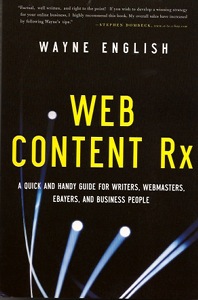
Web Content RX book cover
Wayne English believes the quality of online content is important. He also believes that web content, design and keywords are equally important. That is why he included web development information in his recently published book Web Content Rx A Quick and Handy Guide for Writers, Webmasters, Ebayers and Business People (Career Press, $7.99). In the book, he includes insights on writing easy-to-understand content, choosing a good design, preparing eBay ads, making email addresses unreadable by spammers, and the abc’s of making a podcast and blogging.
The 240-page softcover book is divided into eleven chapters: Get Read or Get Lost – Your Content Decides; Writing Your Content; Content That Sells; Using Automated and Other People’s Content; E-mail; Your Blog; Getting Found: Content and Search Engines; User-Generated and User-Maintained Content; Communication; Podcasting; and Digital Photography.
There are also 10 appendices: Grammar, A Writer’s Checklist, Web Design and HTML, Your Business, A Short Style Guide and Confused Words, Online Tools, HTML Characters and Special Characters; Unspammable E-mail Code, An Almost Foolproof Data Backup Scheme, and Site Search with Google.

Author Wayne English
English, formerly a professional photographer, is the founder of WebContentRx.com. He makes his living writing online oriented content; doing website analysis; launching e-mail campaigns; and marketing websites for clients.

Click here to buy Web Content Rx
Comments:
Filed Under: Books
Posted by Elena del Valle on July 29, 2009
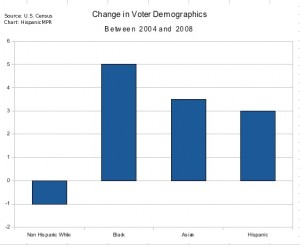
Voter Change Between 2004 and 2008
Sixty-six percent of white non Hispanic voters voted in 2008. That represents a 1 percent decrease compared to 2004. In contrast, minority voter participation increased over the same time period, according to recently released United States Census data. Black turnout at the polls went up 5 percent to 65 percent; Hispanic turnout went up 3 percent and Asian voter turnout went up 3.5 percent, making each group reach almost 50 percent. Many, if not most of these people, cast their votes in favor of the new Democratic President.
Viewed as an unlikely combined voting block the three minority groups would represent almost one quarter of all voters. While they may not agree on all their political viewpoints, in the most recent election, according to the Census, they agreed on one individual, Barack Obama. Among voters 18 to 24 black voters had the highest turnout rate at 55 percent. That represents an 8 point increase compared to 2004. White turnout remained at 49 percent while Asian turnout was 41 percent and Hispanic turnout was 39 percent.
What do these numbers say to marketers and politicians? That the voter profile is changing. There are many ethnic and cultural groups represented among the young adults joining the ranks of voters and they bring with them their own unique perspectives about voting and the election process. This is easy to see in states with a population rich in minorities.
In Florida, for example, almost all of the new 579,000 voters were black or Hispanic. And turnout among young voters increased 10 percentage points from the last election, from 39 percent to 49 percent. Those 75 and older, on the other hand, were less likely to vote. Their numbers dropped from 72 percent to 69 percent between the two election years.
If these changes continue in future elections it would appear the minority vote is growing and may again play a role in the overall voting outcome. Those in the business of influencing political opinions may want to keep that in mind as they craft political messages and outline campaign efforts in the future.
Reach Hispanics online today with
“Marketing to Hispanics Online” audio recording
Identifying and characterizing the booming Hispanic online market



Joel Bary, Alex Carvallo and Matias Perel
Find out about
• The 16 million Latino online users
• Latino online users by gender
• What they do online
• Their language preferences
• How to reach Hispanic urban youth online
• What affects their online behavior
• What influences their purchases
Click here for information about “Marketing to Hispanics Online”
Posted by Elena del Valle on July 28, 2009

Andres Reyes Gonzalez
Are you looking for a team player who really knows how to reach the Hispanic market in the US?
I’m Andrés Reyes, currently living in the Miami FL area; I have a Bachelor of Science Degree in Communication with a major in Journalism from the University of La Sabana from Colombia. I have 5 years of experience in corporate, journalistic and advertising communication.
Click here for the full text of Communications Specialist Latin audiences
Posted by Elena del Valle on July 28, 2009
Information provided by our Event Partner

Hispanic Television Summit
September 23-24, 2009
Marriott Marquis Hotel in Times Square, New York
Two leading, television business publications, Multichannel News and Broadcasting & Cable will again co-operatively present the seventh annual Hispanic Television Summit, which has earned the distinction of being the premiere event for those in Hispanic digital video, media and related businesses.
The two-day conference will be held on Wednesday, September 23 and Thursday, September 24, 2009 at the Marriott Marquis Hotel in Times Square, New York.
This year, for the first time, the Hispanic Television Summit is scheduled in tandem with Advertising Week New York 2009 and serves as the Hispanic cornerstone of the week-long series of events and conferences.
As a result of the Summit’s affiliation with the increasingly-popular Advertising Week, attendance is expected to exceed the previous record of 400 executives. Attendees of the Hispanic Television Summit traditionally reflect programming, production, research, advertising, agencies, audience measurement, financial investment, and distribution (broadcast TV, cable, satellite, broadband and telephony).
The topics and discussion will be “fresh” and reflective of the current business environment. The theme of this year’s Summit is “Generating Revenues For Hispanic TV….From Advertising, Subscription Fees and Transactions”. Each of the three keynote presentations and five panel conversations will focus on how Hispanic television continues to make money in these tough economic times.
Keynote presenters will include pay TV, advertising and broadcast leaders like Telemundo’s CEO, Don Browne. Panels address topics like – – increasing advertising revenues; marketing pay TV and transactional programming to Hispanic consumers; programming for Hispanic male viewers; driving viewership of Hispanic TV programming through targeted experiential tune-in promotions; and the challenges faced by programmers of Hispanic content for distribution in a multi-screen environment.
Additionally, there are numerous opportunities for networking with other attendees, including several coffee breaks, Wednesday’s opening dessert reception (1-2 pm) and cocktail reception (5 – 7 pm) as well as Thursday’s continental breakfast (8-8:45 am), and closing Awards luncheon (12:30 – 2:30 pm). A special lounge area is available to attendees for small, informal meetings and casual conversations.
The Summit will open with a keynote address at 2 pm on Wednesday, September 23 and concludes promptly at 2:30 pm on Thursday, September 24 with the Closing Luncheon, Award Presentation and Final Keynote address.
Each year, the Summit presents the Award in recognition for Achievement in Hispanic Television. The 2008 award was presented to Univision’s leading anchorperson, Jorge Ramos. Previous recipients also include talk show host, Cristina Saralegui, journalist Maria Celeste Arraras, sportscaster Andres Cantor and Mario Kreutzberger “Don Francisco”, the host of the world’s longest-running TV program, Sabado Gigante.
Early-bird Registration rates of $399 (save $100) are effective until September 1, 2009 and group discount rates also apply for additional savings. Register on-line at multichannelnews.com/hispanicsummit. The Summit is produced for Multichannel News and Broadcasting & Cable by the Schramm Marketing Group of New York.
Register at www.broadcastingcable.com/hispanicsummit09
Posted by Elena del Valle on July 27, 2009
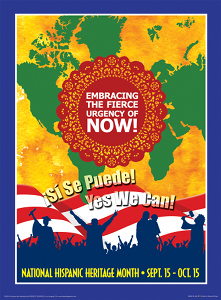
2009 Hispanic Heritage Month poster for sale at Diversity Graphics
Photo: Diversity Graphics
Every year, companies across the country seek the patronage of Latino and Latino oriented customers between mid September and mid October during Hispanic Heritage Month. And, many organizations serving Latino communities take advantage of the opportunity to seek exposure and showcase their successes.
This year, for example, the Congressional Hispanic Caucus Institute (CHCI) plans Latinos Leading in a Global Society events sponsored by Wal-Mart Stores; KCET, a Southern California TV station, will celebrate through a Hispanic Heritage Month Local Heroes Award; the National Football League and ESPN will celebrate Hispanic Heritage Month with a series of special events surrounding the New York Jets at Miami Dolphins Monday Night Football game on Monday, October 12; and NBC’s Washington, D.C. affiliate is holding a Hispanic Heritage Month Essay Contest to name just some examples.
Ana Rodrigues, an artist from New York, with the guidance of Steven Rodiguez of Diversity Graphics, designed the company’s 2009 Hispanic Heritage Poster. The poster represents Hispanic/Latino culture throughout the world and the community’s impact on American society. The artists included an image of the continents, the American Flag and the silhouettes of various figures including a graduate, a judge, family and politician along with the phrase “¡Sí Se Puede!” to reflect “unity, empowerment, and the importance to get involved.”
“Diversity Graphics has been celebrating Hispanic Heritage Month (and all other major celebrations) for over 25 years, providing posters, buttons and other materials for sale to help others celebrate in the workforce, schools or public thus educating the importance of Diversity. Hispanic Heritage Month is one of our most successful celebrations,” said Mark Martinez, owner of the the California company.
How and when did this tradition get started? In September 1968 when Congress and then President Lyndon B. Johnson proclaimed National Hispanic Heritage Week to celebrate the culture and traditions of people with roots in Spain, Mexico and the Spanish-speaking nations of Central America, South America and the Caribbean. Twenty years later the observance was extended to a month.
According to the United States Census Bureau, September 15 was chosen as the first day for the celebration because it is the anniversary of independence of five Latin American countries: Costa Rica, El Salvador, Guatemala, Honduras and Nicaragua. In addition, Mexico and Chile celebrate their independence days on September 16 and September 18, respectively.
Why do so many companies care about Hispanic customers? Even by the conservative estimates of the United States government, as of the most recent figures released there are 47 million Latinos (46.9 million) in the country, representing 15 percent of the population. That does not include another 4 million souls on the island of Puerto Rico. Looking toward the future those who estimate population size and composition believe there will be 132.8 million Latinos in the United States on July 1, 2050, representing 30 percent of the population.
If we look at the numbers in another way, the Hispanic population in the United States in 2008 was second only in size to that of one country, Mexico. That is because our neighbor to the south has a population estimated at 110 million, more than double the Hispanic population of the United
States (46.9 million).
At the same time, there are 16 states with at least a half-million Hispanic residents: Arizona, California, Colorado, Florida, Georgia, Illinois, Massachusetts, Nevada, New Jersey, New Mexico, New York, North Carolina, Pennsylvania, Texas, Virginia and Washington. Yet, being Hispanic isn’t just about speaking Spanish. Although in 2007, 35 million U.S. residents five and older spoke Spanish at home more than half of these Spanish speakers spoke English “very well,” according to the Census folks.
Target Latinos effectively by understanding how they shop
“Hispanic Holiday Shopping Patterns” audio recording

Manuel Delgado, CEO Agua Marketing, gives a presentation and participates in an extended Q&A discussion about
- Hispanic shopping patterns national survey
- Why Latino consumers may be more desirable than general market shoppers
- Hispanics holiday shopping patterns and behaviors
Click here for information on “Hispanic Holiday Shopping Patterns” audio recording
Posted by Elena del Valle on July 24, 2009

Whistlefritz Spanish for Beginners DVD cover
Parents who want their children aged two to seven to learn Spanish will have a new teaching tool beginning September 2009, Whistlefritz Spanish for Beginners Inside and Out, a 30-minute high definition animated DVD course for children. The $19.99 recording is available at major online retailers and libraries.
In the DVD, Maria, a teacher, and her friend Fritzi, a mouse, teach children the names of the rooms of a house and its contents and then go outdoors to a playground. It includes a translation guide for parents with the list of words in Spanish.
Heidi Stock first developed the concept in 2006 to teach her own kids how to speak Spanish. She didn’t like the existing tools and decided to create her own. The first two titles were Spanish for Beginners Vamos a Jugar (Let’s Play) and Spanish for Beginners Los Animales (The Animals). ¡A Bailar!, a music CD, is also available.
Vamos a Jugar received the 2007 iParenting Media Award, Parents Choice Approved Award, National Parents Centers’s 2007 Seal of Approval, the National Parenting Publications Awards’ 2007 Honors Award and the Creative Child Magazine 2007 Seal of Excellence.

Click here to buy Spanish for Beginners: Adentro y Afuera (Inside and Out)
Click here to buy Spanish for Beginners: Vamos a Jugar (Let’s Play)
Click to buy Spanish for Beginners: Los Animales (Animals)
Click here to buy A Bailar! Let’s Dance!
Posted by Elena del Valle on July 22, 2009

Georgina Flores, senior marketing manager, Allstate
Photo, videos: Allstate
In an effort to target budget conscious Spanish dominant Latinos Allstate launched a national television ad campaign earlier this year. The first Spanish language ad ran in the second quarter of 2009 and the second ad began airing this month. There are plans for additional spots later this year. The ads have been airing on Univision and Telemundo networks. Information on audience response to the ads was not yet available.
The insurance company plans to run the commercials during the MNT games, Premio lo Nuestro and the Latin Grammys, as well as during regular programming, according to a company spokesperson who responded to questions by email. Scroll down to see videos of the two ads.
The ads are part of the company’s Hispanic marketing program which also includes radio advertising, a Spanish language portal, online activations, media integrations, sponsorship of the Mexican National Soccer Team (for the third consecutive year), and sponsorship of highly rated television and radio entertainment programs.
“Allstate’s dedication to the Hispanic community begins internally, extends to our Hispanic advertising and public relations programs, and reaches Hispanic consumers where they work and live,” said Georgina Flores, senior marketing manager for Allstate. “Our involvement within the Hispanic community is not a trend – it is part of our culture – and we are here to provide peace of mind for consumers during these tough economic times.”
The two Spanish language ads, created by Lapiz, Allstate’s agency of record, focus on the recession and invite the viewers to reach out to the insurance company for support in weathering the economic storm. In one, “Load,” a young man is overstuffing a load of laundry at a laundromat; in the other, “Cobbler,” a young man takes his shoes to be fixed at the shoe repair shop.
Allstate’s Spanish language website received a Silver Award from the Advertising Research Foundation in the multicultural banking and insurance category. There are more than 3,000 Allstate agencies with Spanish-speaking capabilities and the company offers claims and customer service in Spanish round the clock via a toll free number.
According to promotional materials, the Allstate Corporation is the nation’s largest publicly held personal lines insurer, providing services to 17 million households. The company has 14,700 exclusive Allstate agencies and financial representatives in the United States and Canada.
Click on the play button to watch the “Load” and “Cobbler” ads below:
Comments:
Filed Under: Video
Posted by Elena del Valle on July 21, 2009
Information provided by our Event Partner
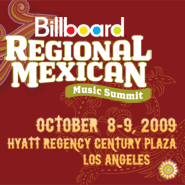
Billboard Regional Mexican Music Summit – Oct. 8-9, 2009
Hyatt Regency Century Plaza – Los Angeles
Save the date!
Special Rate for HispanicMPR
Use Promo Code: HMPR to Register Today For Only $225! A $225 Savings!
Go to http://www.billboardevents.com/billboardevents/rmms/eng/registration/index.jsp
Registrations Issues? Contact Lisa Kastner at 646-654-4643 or LKastner@billboard.com
Now in its 4th year, this unique summit celebrates regional Mexican music and unites the key industry players that drive this lucrative sector of the Latin music business.
Superstar Keynote Q & A with Alejandro Fernandez!
Panel topics include:
• The Latest Indie Business Models
• Surviving the Recession: Investing Wisely
• The New Wave of Corridos
• The Hottest Radio, Touring and Digital Trends
• The Rise of Regional Mexican Music in Television
Register Today & Save with the promo code: HMPR at
http://www.billboardevents.com/billboardevents/rmms/eng/registration/index.jsp
Posted by Elena del Valle on July 20, 2009

An agricultural field
As we face one of the deepest recessions in our young nation’s history and record unemployment it’s hard to believe there was so much talk about and concern with immigration in the last years. With many families facing financial problems, foreclosures, business closures and job loss most people’s energy is focused on worrying about issues that affect them tangibly and directly rather than possible new arrivals, undocumented or documented.
Gone are the days of plenty. Today many live frugally and contemplate the increasingly fashionable and very practical transumerism (renting rather than buying non essential items). While there surely are still migrant workers in agriculture and construction, among other industries, the number of immigrants that cross the United States southern border, for example, has declined noticeably since our country’s financial woes became pronounced. As the number of jobs declines, the number of workers migrating north also drops (see Mexican immigration declined sharply last year).
Doors that once stood mainly open to immigrants in the United States and other industrialized nations are less open, relying on heightened permit processes and not so friendly legislation to keep aspiring visitors at bay. For example, the Employ American Workers Act, part of the fiscal stimulus bill, places stricter conditions than in previous years; and on companies receiving financial support from the government that want to hire skilled foreigners under the H-1B visa program.
This, and the weak economy, has caused some American banks and other financial-services firms to withdraw job offers to foreign-born graduates of American universities and postgraduate programs. And, according to a recent article in The Economist, some people who work in the United States are finding it harder than in the past to renew their residency permits.
In some places the attitudes toward migrant workers have toughened or worsened. Xenophobia has a fan base (listen to interview with Mark Potok of the Southern Law Poverty Center about anti-immigrant hate crimes in America). We are not alone as a nation. Countries like South Africa, Spain and Ireland have seen bouts of violence against foreigners. In Northern Ireland, Romanian workers have been attacked; in Australia, Indian students have been the targets of displeased citizens participating in manifestations; while in South Africa anyone thought foreign and working for lower wages than the locals was at risk of bloody and at times deadly attacks last year.
“Moving Beyond Traditional Media Measurement: measuring conversations and social media” audio recording

Presenter Katie Delahaye Paine, founder, KDPaine & Partners
Find out about
- Issues affecting online public relationships today
- Testing relationships as part of a survey
- Measuring ethnic group relationships
- Measuring foreign language communications in a similar ways to English
- Biggest challenges measuring conversations and social media
- Measuring online relationships with little or no money
Click here for information on “Moving Beyond Traditional Media Measurement”
Posted by Elena del Valle on July 17, 2009
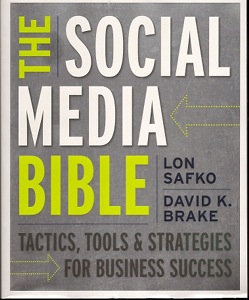
The Social Media Bible book cover
The Social Media Bible Tactics, Tools and Strategies for Business Success (Wiley, $29.94), a 821-page tome from Lon Safko and David K. Brake published earlier this year, outlines basic social media issues in 43 chapters. The soft cover book is divided into three parts: Background Basics and Tactics (chapters 1-23), Tools (chapters 24-38) and Strategy (chapters 38-43). The authors believe that readers who successfully implement the strategies they outline in the book may increase revenues, improve profitability and remain relevant in their industry.
The two authors relied on 48 experts and authors from companies such as Wiley & Sons, Inc., Publishing, Flicker, Twitter, YouTube, Google, Yelp, LinkedIn, and MySpace, among others, to enhance their contribution to the book and its partner website. The book project required almost two years of planning and about six months to write.
“The most challenging aspect of writing a 43 chapter, 844 page book on social media was the wrapping my brain around the extensive landscape of social media. I took months to gather information about the hundreds of companies and tools then creating the 15 basic categories of social media applications,” said Safko by email when asked what were the most challenging and rewarding aspects of the project. “Then the real work began; researching each of these technologies and compiling all of their histories, features, benefits, and interviewing nearly 50 of the world leaders on social media; Biz Stone, Twitter, Matt Mullenweg, WordPress, SVP YouTube, SVP, Flickr, VP MySpace, and even Peter Wiley, chairman of the Board for John Wiley & Sons, and Vint Cerf, the inventor of the Internet.
The most rewarding aspect of creating this work is the testimonials and stories I hear on a daily basis about how this book is answering so many peoples questions about social media and where they do they begin. Business people are both excited and stressed about social media. They all know social media is changing the way we all do business, but they don’t know how they should be applying it. The hear that this book is helping so many people is the most valuable reward I could have hoped for.”
The first section is designed to serve as an introduction on social media and its varied applications; they delve deeper in the second part where they address 100 social media tools and applications in 15 categories; in the last section, they share exercises for readers to determine their individual needs to facilitate their efforts at crafting and developing social media strategies for their business or company.
Safko, the founder of eight companies including Paper Models, Inc and LonSafko.com, dedicates his time to public speaking and developing innovative ideas. He has 20 years of experience in entrepreneurship, marketing, sales, training and e-commerce. Brake is the chief executive officer of Content Connections, a social media strategies company.
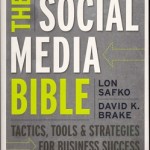
Click here to buy The Social Media Bible
Comments:
Filed Under: Books




























